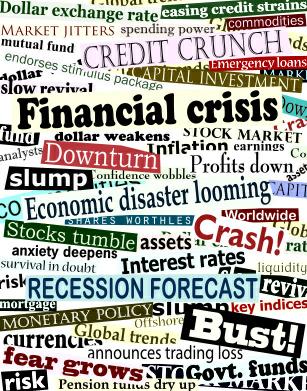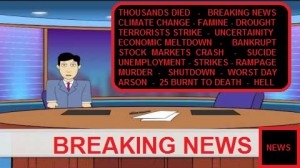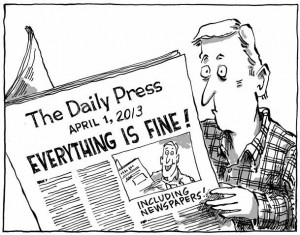I love discussions over current political situations and scenarios, read and watch the news (almost) everyday, and have friends and family to discuss the news with. It occurs to me:

“Why is the news so negative”
Every news-person and journalist I happened to inquire, gave me the response on these lines:
“Negative? This is reality. The world is a bad place. Bad things happen. We’re trying to make the world better by telling people about it the way it is. People murder their families. Kids and teens are kidnapped. Terrorists are trying to kill you; bomb blasts happen everyday. Dozens of people are being shot dead everyday. We’re at war. The politicians, the government, are corrupt; the army, the judiciary and agencies are plotting against you. Incredible car accidents, train wrecks and plane crashes take place on a regular basis and you need to know about them. The world is giving you cancer. Terrible plagues are on their way. Climate change is here, and we’re all going to die.”
 What is wrong with all this? This is the reality we’re made to believe each time we switch on the T.V., isn’t it?
What is wrong with all this? This is the reality we’re made to believe each time we switch on the T.V., isn’t it?
I love newspapers and TV news, and I’ve mostly seen negativity as a by-product of freedom of the press – freedom to criticize those is power and expose crime, corruption, inaction, inequality and injustices. But in the last few years, something changed. I started finding news, TV news in particular, irritating, painful, disturbing, even traumatic. Repetitive. Torturous. Paranoid. Overkill. I’d turn on Geo and hear an unrelenting charge of corruption, accusations against the government, inflation, instability, murders, deaths, explosions, disasters, tragedies, terrorists and apocalyptic predictions.
Perhaps the world has simply gotten worse in the last decade. Climate change, terrorism, hyperinflation, economic decline, and war have made the news cycle more frightening. But I don’t think viewers take issue with this type of negativity. They understand the state of the world. They watch the news.
This is what is meant by negative:
 You see a dry, windy day, the media see climate change. You see a road, the media sees car accidents, traffic jams, and pollution. You see a protest and the media shouts that the government must go. You see a religious festival or public holiday ahead, the media alert us a terrorist attack is imminent. You see an empty street, the media see street crimes, armed robberies and target killings. You see a glass half-full, the media tell you the remaining water in that glass could be contaminated with cyanide by terrorists. You say: “Have a nice day,” the media say: “It started off as a nice day, but it ended in murder, car accidents, a fire, bank robberies, a frightening new trend and arrests. Detailed news after the break.”
You see a dry, windy day, the media see climate change. You see a road, the media sees car accidents, traffic jams, and pollution. You see a protest and the media shouts that the government must go. You see a religious festival or public holiday ahead, the media alert us a terrorist attack is imminent. You see an empty street, the media see street crimes, armed robberies and target killings. You see a glass half-full, the media tell you the remaining water in that glass could be contaminated with cyanide by terrorists. You say: “Have a nice day,” the media say: “It started off as a nice day, but it ended in murder, car accidents, a fire, bank robberies, a frightening new trend and arrests. Detailed news after the break.”
If you had a friend who talked like TV news, you’d probably think that friend was an idiot, paranoid, hyper, morbid, manic and clinically depressed.
Television networks, particularly 24-hour news networks, come alive when a war starts. This is no accident. War reporting is one of journalism’s core assignments and, not accidentally, the greatest driver of ratings.
War and its attendant horrors might have forged and woven the very fabric of journalism. Some people say that the popular inverted pyramid reporting style has its roots in war. War reporters, always fearful of having their stories cut off by the telegraph, wrote stories in a hierarchy of carnage where the deaths came first, followed by injuries.
While this theory is disputed, the pyramid style persists and has a led to an obsession with body counts and violence. Stories are more important if more people die, and readers find that news stories trail off without any kind of … conclusion. They’ll show you an accident, but they won’t tell you why it happened or how to prevent it next time.
And the very language of journalism is said to have come from war. A politician will face a “barrage of questions,” bills are “torpedoed” and exciting new books are “explosive.” In Pakistan, the evening news has something related to this: “Today, 15 people were shot dead in different parts of Karachi” being accompanied by images of an ambulance being sent off from the crime scene, the traumatized victim or his/her dead body being moved around in the hospital and finally scenes of crying and wailing women and then men. After the final ‘sensational’ development of the news, the channels would lay claims that they were the first ones to break the news first to you.
The number of dead are reported in this manner: “The explosion claimed 31 lives, which included 24 women and children”. 31 and 24 seen quite high together, a psychological effect intended at creating a sensation, and spark interest (read: horror) among the viewers, to keep them glued to their seats, make them depressed.

Perhaps people have gotten hooked on negative news the way people got hooked on junk food. And here is perhaps the most popular argument in favor of media negativity. It’s what the people want. But is it really?
Good and happy news are flashed on the TV too, like winning a cricket or hockey match, but isn’t that too short lived, and not given the attention it duly deserves? Would you like to listen to any good news?
If the media are too negative, there is one person who might have the power and the ideas to change it.
That’s you!

Leave a Reply